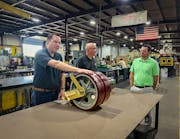It is a well-known fact, unrecognized by science it is true, but nonetheless accurate, that small bitty parts including screws, washers, nuts and bolts and miscellaneous parts have eyes. It is also recognized that these bitty parts also have volition and control over their movements, at least after being inadvertently dropped. As I said, science has not noticed this but every mechanic and technician knows that if you accidently drop a part when working on an engine or other equipment, that it will seek out a hole, crevice, or nook or cranny to hide itself. This is doubly true if working against a deadline or tight schedule or even better, a delayed flight.
How else to explain how these little parts vanish from the ken of man when desperately needed? Also, how do they find the exact place to net where they will jam some control or get caught in gearing or machinery if not found and removed? How do they know it is dark or better yet there is snow on the ground? I rest my case for their eyes and volition.
Missing Part
I was working a DC-6B of a long gone airline engaged in replacing a propeller synchronizer box. The box, after much study by the design engineers, had been mounted on the cockpit floor sandwiched between the radio rack and the fuselage skin and structure. With my long arms and, at that time, skinny frame, I was an ideal choice to worm my way into the gap aft of the radio rack and then reach around forward to get to the box. The sync box was an electronic marvel whose only moving part was a shaft sticking out which was turned by an arm.
This arm in turn was moved by an Ahren’s control (push-pull cable) which led to the prop control lever on the pilot’s pedestal.
This arm had to be adjusted to allow full travel and for this they used a vernier adapter that fit between shaft and arm. This was a small ferrule with teeth on its inside hole and outside diameter. It was a small but unique part that I had to repeatedly take off the box shaft, rotate it a tooth or two to put back on, then the arm, try it for proper rigging and repeat this until the arm and the control lever were synchronized and had full travel. Just as I nearly had it adjusted, I dropped it. It fell a few inches, hit the floor, bounced and looked around and saw a small gap between the floor structure and a fuselage frame and made a hole in one. Clink and clung, it disappeared from view under the floor.
What was under the floor? It was the forward baggage compartment, or at least the space behind the sidewall of the forward baggage. With a sinking heart, I informed the lead mechanic who, in turn, realized the forward bag pit was already loaded with the passengers' luggage. You cannot imagine the screams of rage and the level of profanity directed at the maintenance department when the bag smashers were informed they would have to unload the forward end of the front bag pit so we could remove the sidewall cover with its numerous screws and then search for the missing adapter. They thought they were finished except for last-minute bags and some had already drawn their cups of coffee.
Meanwhile, another mechanic researched the parts catalog in the hope of finding the part number of the adapter so they could try to get one from stock. It was very unlikely that we stocked it at all. It developed it was one of those parts that the airframe manufacturer considered as part of the box, hence, did not list it in the DC-6 illustrated parts catalog and one that only the box manufacturer listed in his overhaul manual for the box. You generally do not have component overhaul manuals out in line maintenance. So it was necessary to find that little bitty part.
Bags removed, we attacked the screws holding the sidewall cover, opened it and using a magnetic probe, searched each stringer under the estimated location of the radio rack. It was sheer luck that it was quickly found and, under the stern eye of the lead mechanic, I returned to my uncomfortable position wrapped around the aft end of the radio rack. I did place a piece of tape over the grinning chasm that had swallowed the adapter before. For a wonder, on the first try the arm was in perfect adjustment and I finished it up, sifted the nut on the box, made the proper log entries and, the baggage sidewall having been closed up, released the aircraft to service. We refrained from calling it a baggage loading delay even though they were still pitching in bags as we left the scene.
Hiding Places
Downdraft carburetors on ground equipment present an interesting opportunity for bitty parts to hide themselves. The GSE shop was replacing a carburetor on some huge V-8 engine.
Foolishly, the mechanics did not cover or even stuff rags into the yawning hole where the carb was seated. They had the replacement in hand they were going to put right on. While cleaning the gasket crud off the seat on the manifold, the paper cup holding the removed nuts, clips and washers was upset. Recognizing the opportunity, several bitty parts made a perfect score and dripped down into the manifold below. Diligent use of the magnet, mechanical fingers, etc., failed to account for all of them. Of course, some had also spilled down below into the maze of lines, hoses and harnesses that fill engine compartments. Also, there was no good count of the parts and so one could not be positively sure that all the hardware had been removed from inside the intake.
I only got involved in that one by virtue of being the maintenance manager of the station who had to be approached by the GSE supervisor to approve some overtime. On getting a full confession of the reason, I allowed the overtime needed to cover the removal of the manifold. It was a good thing we had, for indeed a nut had made its way and was perched next to one of the intake valves. At best, it could have wedged the valve open leading to some very loud backfires. Then again, we might have the piston hitting the opened valve, it breaking off and two bits chewing up head, piston and maybe the liner. Honesty in admitting the problem and prudence in removing the manifold paid off as they usually do.



